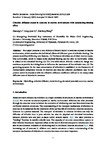Chloride diffusion model for concrete in marine environment with considering binding effect
| dc.contributor.author | Li, Long-yuan | |
| dc.date.accessioned | 2019-03-23T04:42:29Z | |
| dc.date.issued | 2019-07 | |
| dc.identifier.issn | 0951-8339 | |
| dc.identifier.issn | 1873-4170 | |
| dc.identifier.uri | http://hdl.handle.net/10026.1/13522 | |
| dc.description.abstract |
This paper presents a new chloride diffusion model for concrete exposed to marine environment, which considers the effects of different types of chloride binding. The present model has following new features. (1) The bound chlorides are divided into two types. One is reversible, which is related to the physical binding, and the other is irreversible, which is related to the chemical binding. (2) The reversible bound chloride remains its charge and continues to provide its driving force to influence the movement of free chloride ions. (3) The governing equation for the mass conservation of chlorides is established on the framework of representative elementary volume of concrete and thus the diffusion coefficient used in the present model is consistent with the effective diffusion coefficient defined in the steady-state diffusion tests of chloride in concrete. | |
| dc.format.extent | 44-51 | |
| dc.language | en | |
| dc.language.iso | en | |
| dc.publisher | Elsevier | |
| dc.subject | Modelling | |
| dc.subject | Chloride diffusion | |
| dc.subject | Ionic binding | |
| dc.subject | Chemical potential | |
| dc.subject | Concrete | |
| dc.subject | Marine environment | |
| dc.title | Chloride diffusion model for concrete in marine environment with considering binding effect | |
| dc.type | journal-article | |
| dc.type | Journal Article | |
| plymouth.author-url | https://www.webofscience.com/api/gateway?GWVersion=2&SrcApp=PARTNER_APP&SrcAuth=LinksAMR&KeyUT=WOS:000471362100004&DestLinkType=FullRecord&DestApp=ALL_WOS&UsrCustomerID=11bb513d99f797142bcfeffcc58ea008 | |
| plymouth.volume | 66 | |
| plymouth.publication-status | Published | |
| plymouth.journal | Marine Structures | |
| dc.identifier.doi | 10.1016/j.marstruc.2019.03.004 | |
| plymouth.organisational-group | /Plymouth | |
| plymouth.organisational-group | /Plymouth/Faculty of Science and Engineering | |
| plymouth.organisational-group | /Plymouth/Faculty of Science and Engineering/School of Engineering, Computing and Mathematics | |
| plymouth.organisational-group | /Plymouth/REF 2021 Researchers by UoA | |
| plymouth.organisational-group | /Plymouth/REF 2021 Researchers by UoA/UoA12 Engineering | |
| plymouth.organisational-group | /Plymouth/Research Groups | |
| plymouth.organisational-group | /Plymouth/Research Groups/Marine Institute | |
| plymouth.organisational-group | /Plymouth/Users by role | |
| plymouth.organisational-group | /Plymouth/Users by role/Academics | |
| dcterms.dateAccepted | 2019-03-14 | |
| dc.rights.embargodate | 2020-3-21 | |
| dc.identifier.eissn | 1873-4170 | |
| dc.rights.embargoperiod | Not known | |
| rioxxterms.funder | European Commission | |
| rioxxterms.identifier.project | Tailor-made Recycled Aggregate Concretes | |
| rioxxterms.versionofrecord | 10.1016/j.marstruc.2019.03.004 | |
| rioxxterms.licenseref.uri | http://www.rioxx.net/licenses/all-rights-reserved | |
| rioxxterms.licenseref.startdate | 2019-07 | |
| rioxxterms.type | Journal Article/Review | |
| plymouth.funder | Tailor-made Recycled Aggregate Concretes::European Commission |


